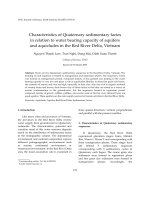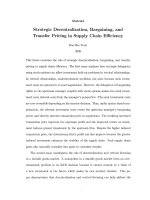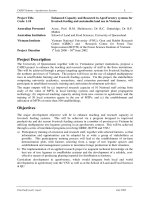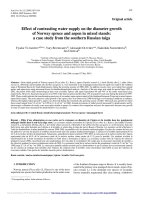capacity allocation and rescheduling in supply chains
Bạn đang xem bản rút gọn của tài liệu. Xem và tải ngay bản đầy đủ của tài liệu tại đây (500.68 KB, 141 trang )
c
Copyright by
Zhixin Liu
2007
ABSTRACT
In the first part of the dissertation, we study the problem of rescheduling for
multiple new orders. Assume that a set of original jobs has been scheduled on a single
machine, but not processed, when a set of new jobs arrives. The decision maker needs
to insert the new jobs into the existing schedule without excessively changing it. The
objective is minimization of the maximum lateness of the jobs, sub je ct to a customer
service requirement modeled by a limit on the maximum time change of the original
jobs. Since the schedule of the original jobs can be arbitrary, this problem mo dels
multiple disruptions from repeated new job arrivals. We show that this scheduling
problem is intractable, even if no new jobs arrive. We describe several approximation
algorithms and analyze their worst-case performance. Next, we deve lop a branch
and bound algorithm that uses a variable neighborhood descent algorithm to obtain
an initial upper bound, several dominance properties that we establish, and a lower
bounding scheme based on a preemptive relaxation of the problem. The branch and
bound algorithm solves 99.9% of randomly generated instances with up to 1000 jobs
within 60 seconds. Our work demonstrates for the first time that optimization of
large scale, intractable rescheduling problems is possible. More generally, it refocuses
the literature on scheduling problems towards rescheduling issues.
In the second part of the dissertation, we consider a multiple product supply chain
where a manufacturer receives orders from several distributors. If the orders cannot
ii
all be met from available production capacity, then the manufacturer allocates that
capacity among the distributors. The distributors may share their allocated capacity
among themselves before submitting revised orders. Finally, the manufacturer sched-
ules the revised orders to minimize its cost. We consider three practical coordination
issues. First, we estimate the benefit to the manufacturer from considering scheduling
costs and constraints in making capacity allocation decisions. Second, we estimate
the additional profit that the distributors achieve when they share their allocated
capacity. Third, we estimate the value of coordination between the manufacturer
and the distributors. Our work is the first to consider all three issues simultaneously.
We model scheduling costs and constraints within the manufacturer’s capacity allo-
cation problem, model the distributors’ capacity sharing problem as a cooperative
game which has properties that are unique within cooperative game theory, and de-
velop optimal algorithms for all the models defined by the three coordination issues.
Our exact evaluation of decisions about the appropriate coordination level improves
managers’ ability to make those decisions.
In the third part of the dissertation, we consider a problem where a group of
agents, each with a set of jobs, need to schedule their jobs on a common processing
facility. Each agent wants to minimize an objective function which depends on its
own job completion times. Time slots are allocated to the various jobs based on
the bids of the participating agents. We investigate the efficiency and effectiveness of
three ascending auction mechanisms, with market goods consisting of time slots, fixed
time blocks, and flexible time blocks, respectively. For all three market goods, we
demonstrate the efficiency of our auction mechanism, and develop optimal algorithms
for the winner-determination and bid-determination problems. We find that if flexible
iii
time blocks are defined as market goods, then it is guaranteed that the allocation
which results from the auction is a Pareto optimal solution. Finally, by developing
a counterexample to a well known result, we show that for the case of time blocks,
there may not exist an equilibrium solution that is globally optimal.
iv
Dedicated to:
Meng, the love of my life
My parents, for their support
v
ACKNOWLED GMENT S
I would like to express my sincere appreciation to my adviser Professor Nicholas G.
Hall, whose inspiration, guidance and advice made this dissertation possible, and who
has influenced me far beyond this dissertation. During the four years of my Ph.D.
study, I have learned a great deal academically and personally from him.
My thanks go to my dissertation committee for their intellectual supp ort. I am
grateful to Professor Marc E. Posner for insightful advice and discussion regarding
Chapter 3. He also taught me several optimization courses and introduced me to
recent developments in scheduling theory. Thanks to Professor Suvrajeet Sen for his
time spent in reading this dissertation.
I would like to thank Professor Chris N. Potts, for his guidance and suggestions
regarding Chapter 2. He also verified most of the technical details in this chapter.
Thanks to Wenhui and Xiaoping, for their encouragement and help regarding
every aspect of my life. Thanks to Kejian, for his advice and help about living in
Columbus.
I feel very fortunate to know these people, and many others. Space does not
permit mentioning all of them, for which I apologize.
vi
VITA
December 12, 1976 . . . . . . . . . . . . . . . . . . . . . . . . . Born - Hebei Province, China
1999 . . . . . . . . . . . . . . . . . . . . . . . . . . . . . . . . . . . . . . . .B.S. Computational Mathematics,
Nankai University
2002 . . . . . . . . . . . . . . . . . . . . . . . . . . . . . . . . . . . . . . . .M.S. Operations Research,
Tsinghua University
2002-2003 . . . . . . . . . . . . . . . . . . . . . . . . . . . . . . . . . . Instructor,
The Great Wall Computer School
2003-present . . . . . . . . . . . . . . . . . . . . . . . . . . . . . . . . Graduate Teaching Associate,
Graduate Research Associate,
The Ohio State University
PUBLICATIONS
Research Publications
J. Xie, W. Xing, Z. Liu, J. Dong, “Minimum Deviation Algorithm for Two-Stage
No-Wait Flowshops with Parallel Machines”. Computers & Mathematics with Appli-
cations, 47:1857–1863, 2004.
FIELDS OF STUDY
Major Field: Busines s Administration
Minor Field: Management Information System
Minor Field: Logistics
vii
TABLE OF CONTENTS
Page
Abstract . . . . . . . . . . . . . . . . . . . . . . . . . . . . . . . . . . . . . . . ii
Dedication . . . . . . . . . . . . . . . . . . . . . . . . . . . . . . . . . . . . . . v
Acknowledgments . . . . . . . . . . . . . . . . . . . . . . . . . . . . . . . . . . vi
Vita . . . . . . . . . . . . . . . . . . . . . . . . . . . . . . . . . . . . . . . . . vii
List of Tables . . . . . . . . . . . . . . . . . . . . . . . . . . . . . . . . . . . . x
List of Figures . . . . . . . . . . . . . . . . . . . . . . . . . . . . . . . . . . . xii
Chapters:
1. Introduction . . . . . . . . . . . . . . . . . . . . . . . . . . . . . . . . . . 1
2. Rescheduling for Multiple New Orders . . . . . . . . . . . . . . . . . . . 5
2.1 Introduction . . . . . . . . . . . . . . . . . . . . . . . . . . . . . . 5
2.2 Problem Definition and Computational Complexity . . . . . . . . . 8
2.3 Approximation . . . . . . . . . . . . . . . . . . . . . . . . . . . . . 12
2.3.1 Analysis of specific classes of schedules . . . . . . . . . . . . 13
2.3.2 A best possible approximation algorithm . . . . . . . . . . . 18
2.4 Branch and Bound Algorithm . . . . . . . . . . . . . . . . . . . . . 22
2.4.1 Lower bounds . . . . . . . . . . . . . . . . . . . . . . . . . . 22
2.4.2 Upper bounds . . . . . . . . . . . . . . . . . . . . . . . . . 22
2.4.3 Structural properties . . . . . . . . . . . . . . . . . . . . . . 27
2.4.4 Branch and bound strategy . . . . . . . . . . . . . . . . . . 30
2.5 Computational Results . . . . . . . . . . . . . . . . . . . . . . . . . 31
2.5.1 Heuristics . . . . . . . . . . . . . . . . . . . . . . . . . . . . 32
viii
2.5.2 Branch and bound algorithm . . . . . . . . . . . . . . . . . 35
2.6 Concluding Remarks . . . . . . . . . . . . . . . . . . . . . . . . . . 42
3. Capacity Allocation and Scheduling in Supply Chains . . . . . . . . . . . 44
3.1 Introduction . . . . . . . . . . . . . . . . . . . . . . . . . . . . . . 44
3.2 Preliminaries . . . . . . . . . . . . . . . . . . . . . . . . . . . . . . 48
3.3 Uncoordinated Supply Chain: Manufacturer . . . . . . . . . . . . . 51
3.3.1 Capacity allocation . . . . . . . . . . . . . . . . . . . . . . . 51
3.3.2 Scheduling revised orders . . . . . . . . . . . . . . . . . . . 61
3.4 Uncoordinated Supply Chain: Distributors . . . . . . . . . . . . . . 62
3.4.1 With partial orders . . . . . . . . . . . . . . . . . . . . . . . 62
3.4.2 Without partial orders . . . . . . . . . . . . . . . . . . . . . 70
3.5 Coordinated Supply Chain . . . . . . . . . . . . . . . . . . . . . . . 78
3.6 Computational Study . . . . . . . . . . . . . . . . . . . . . . . . . 81
3.6.1 Manufacturer’s coordination . . . . . . . . . . . . . . . . . . 82
3.6.2 Distributors’ coordination . . . . . . . . . . . . . . . . . . . 85
3.6.3 Supply chain coordination . . . . . . . . . . . . . . . . . . . 87
3.7 Setup Times . . . . . . . . . . . . . . . . . . . . . . . . . . . . . . 89
3.8 Conclusions . . . . . . . . . . . . . . . . . . . . . . . . . . . . . . . 97
4. Noncooperative Scheduling Games with Auctions . . . . . . . . . . . . . 99
4.1 Introduction . . . . . . . . . . . . . . . . . . . . . . . . . . . . . . 99
4.2 Preliminaries . . . . . . . . . . . . . . . . . . . . . . . . . . . . . . 101
4.3 Noncooperative Scheduling Games . . . . . . . . . . . . . . . . . . 106
4.3.1 Time slots . . . . . . . . . . . . . . . . . . . . . . . . . . . . 106
4.3.2 Fixed time blocks . . . . . . . . . . . . . . . . . . . . . . . 108
4.3.3 Flexible time blocks . . . . . . . . . . . . . . . . . . . . . . 114
4.4 Equilibrium Solution with Time Blocks . . . . . . . . . . . . . . . . 117
4.5 Conclusions . . . . . . . . . . . . . . . . . . . . . . . . . . . . . . . 119
Bibliography . . . . . . . . . . . . . . . . . . . . . . . . . . . . . . . . . . . . 121
ix
LIST OF TABLES
Table Page
2.1 Data for Example 1 . . . . . . . . . . . . . . . . . . . . . . . . . . . . 15
2.2 Data for Example 2 . . . . . . . . . . . . . . . . . . . . . . . . . . . . 17
2.3 Data for Example 3 . . . . . . . . . . . . . . . . . . . . . . . . . . . . 18
2.4 Data for Example 4 . . . . . . . . . . . . . . . . . . . . . . . . . . . . 20
2.5 Effect of n on Performance of the Heuristics . . . . . . . . . . . . . . 34
2.6 Effect of n on Performance of the Algorithm . . . . . . . . . . . . . . 35
2.7 Detailed Results for the Branch and Bound Algorithm . . . . . . . . 38
2.8 Effect of n on Performance of the Algorithm on Difficult Instances . . 40
2.9 Effect of Generation Number on Performance for Ancestor Instances . 41
3.1 Instance of Distributors’ LP Game in Theorem 11. . . . . . . . . . . . 68
3.2 Knapsack Game of Theorem 13. . . . . . . . . . . . . . . . . . . . . . 73
3.3 Instance of Knapsack Game with Only Fractional Core Members. . . 76
3.4 Independent Variables to Evaluate Coordination. . . . . . . . . . . . 83
3.5 Selected ANOVA Results of Manufacturer’s Coordination. . . . . . . 84
3.6 Sensitivity Analysis for Manufacturer’s Coordination. . . . . . . . . . 84
x
3.7 Selected ANOVA Results on Value of Distributors’ Coordination. . . 85
3.8 Effect of Partial Orders on Value of Distributors’ Coordination. . . . 86
3.9 Effect of Revenue / Profit Correlation on Value of Distributors’ Coor-
dination. . . . . . . . . . . . . . . . . . . . . . . . . . . . . . . . . . . 86
3.10 Selec ted ANOVA Results for Supply Chain Coordination. . . . . . . . 87
3.11 Effe ct of Revenue / Profit Correlation on Value of Supply Chain Co-
ordination. . . . . . . . . . . . . . . . . . . . . . . . . . . . . . . . . . 88
3.12 Effe ct of Number of Products and Partial Orders on Value of Supply
Chain Coordination. . . . . . . . . . . . . . . . . . . . . . . . . . . . 88
3.13 Sensitivity Analysis for Coordination with Setup Times. . . . . . . . 95
xi
LIST OF FIGURES
Figure Page
1.1 Capacity Allocation and Scheduling Problem. . . . . . . . . . . . . . 3
xii
CHAPTER 1
INTRODUCTION
Scheduling theory originated in the 1950’s, and has developed extensively since.
This research area considers the allocation of resources over time to perform a col-
lection of tasks, with a set of objectives to optimize (Brucker 1998, Pinedo 2002).
Classical scheduling literature assume s that all the tasks and scheduling facilities b e-
long to a single decision maker, and typically requires all the tasks to be processed to
minimize the total scheduling cost. However, with the rapid development of complex
modern production and supply systems, it is becoming increasingly important for a
company to make efficient operational decisions subject to unpredictable customer
demand and complicated interactive behaviors of customers, suppliers, partners and
competitors. In this dissertation, we study scheduling problems with capacity con-
straints faced by manufacturers in competition or coordination with other supply
chain members. Also, in our work, the jobs to be scheduled b e long to various en-
tities, and we use game theory to study problems of capacity allocation and payoff
division. This dissertation is organized into three parts, as follows.
In Chapter 2, we study the problem of rescheduling for multiple new orders. In
recent years, rescheduling has attracted considerable attention, motivated by both im-
portant practical applications and interesting research problems (Vieira et al. 2003).
1
In modern decision making and manufacturing systems, unexpected disruptions com-
monly occur, which necessitates the rescheduling. In a production system facing
unpredictable demand, managers and planners must generate high quality schedules,
and react quickly to unexpected events to revise their schedules effectively. Specifi-
cally, Chapter 2 considers a problem where a set of original jobs has been scheduled
on a single machine, but not processed, when a set of new jobs arrives. The decision
maker needs to insert the new jobs into the existing schedule without excessively
changing it. The objective is minimization of the maximum lateness of the jobs,
subject to a customer service requirement modeled by a limit on the maximum time
change of the original jobs. Since the schedule of the original jobs can be arbitrary,
this problem models multiple disruptions from repeated new job arrivals. Chapter 2
is accepted for journal publication (Hall et al. 2007).
Chapter 3 considers a scheduling problem with capacity allocation issues which
arise when manufacturers are unable to meet all the orders which they have received.
These issues are most c ommon in industries with high fashion content, rapid techno-
logical development, or occasional demand surges (Fisher 1997). We consider capacity
allocation and s cheduling issues in a make-to-order supply chain. The supply chain
includes a manufacturer that produces multiple products in response to orders from
several distributors. We study three practical and significant coordination issues that
arise in this supply chain when the manufacturer’s production capacity is ins ufficient
to meet all the orders. First, we estimate the value of considering scheduling costs
and constraints as part of the manufacturer’s decision to allocate its capacity to the
distributors across products. Allocation of capacity to distributors allows more flex-
ibility than allocation of products. Second, we estimate the value of coordination
2
among the distributors in sharing their allocated capacity. Finally, we estimate the
value of coordination between the manufacturer and the distributors. An important
contribution of our work is the consideration of these three interrelated coordination
issues simultaneously. An overview of the capacity allocation and scheduling prob-
lem appears in Figure 1.1. The left branch represents the uncoordinated system,
and the right branch represents the system where the manufacturer and distributors
coordinate their decisions. Chapter 3 is submitted for journal publication (Hall and
Liu 2007).
The manufacturer receives orders,
but has insufficient capacity to meet
them all.
❄
✲✛
❄
❄
The manufacturer allocates capac-
ity to the distributors, and invites
them to revise their orders.
❄
The distributors share their allo-
cated capacity, and revise their or-
ders to maximize profit.
❄
The manufacturer schedules the re-
vised orders to maximize its profit.
The manufacturer and distributors
jointly determine the orders and the
schedule to maximize the overall
system profit.
Figure 1.1: Capacity Allocation and Scheduling Problem.
In Chapter 4, we study a competitive scheduling problem. Solution methods for
scheduling problems are traditionally developed under the assumption of centrally
3
available information or distributed information with co operative behavior. Neverthe-
less, centralized methods may not be available when agents have competing interests
and privately held information about job requirements and values. In a decentral-
ized scheduling problem, jobs may represent operations such as specific industrial
finishing, me chanical testing, quality control, components assembly, and equipment
maintenance and repair. We consider problems where a group of agents, each with a
set of jobs, needs to schedule their jobs on a common processing facility. Each agent
wants to minimize an objective function which depends on its own job completion
times. We develop ascending auction models to allocate capacity. Time slots are allo-
cated to alternative jobs based on the bids of the participating agents. We investigate
the efficiency and effectiveness of various auction mechanisms, and the optimization
of the agents’ bidding policies.
4
CHAPTER 2
RESCHEDULING FOR MULTIPLE NEW ORDERS
2.1 Introduction
In recent years, rescheduling has attracted considerable attention, motivated by
both important practical issues and interesting research problems. The need for
rescheduling in response to unexpected changes that take place in production en-
vironments is commonplace in modern flexible decision making and manufacturing
systems. In dynamic environments, managers and production planners must not only
generate high quality schedules, but also react quickly to unexpected events and revise
their schedules in a cost-effective manner (Vieira et al. 2003).
In general, there are many possible disruptions that can make rescheduling neces-
sary, including the arrival of new orders, machine breakdowns, shortage of materials
or resources, larger or smaller than expected processing times, cancellation of orders,
changes in order priority, and due date changes.
There are several well-documented real-world applications of rescheduling. Bean
et al. (1991) consider an automobile industry application. They propose a matchup
5
scheduling approach that comp ensates for a disruption. Zweben et al. (1993) de-
scribe the GERRY scheduling and rescheduling system that supports the space shut-
tle using iterative repair heuristics. Clausen et al. (2001) describe a shipyard ap-
plication, where the goal of rescheduling is to store large steel plates for efficient
access. A similar problem occurs in the assignment of stacker cranes to berths at
container ports. Yu et al. (2003), in their work that received the 2002 Edelman Award
of INFORMS ( discuss a
short-range airline planning problem. They describe an optimization-based approach
for rescheduling to compensate for air traffic, weather, crew unavailability, and other
disruptions, which approach helped Continental Airlines recover after the terrorist
attacks of September 11, 2001.
Because of the practical importance of rescheduling, a number of researchers
propose rescheduling approaches for a variety of scheduling environments. Szelke
and Kerr (1994), Davenport and Beck (2000), Herroelen and Leus (2005), Vieira et
al. (2003) and Aytug et al. (2004) provide extensive reviews of the rescheduling lit-
erature, including taxonomies, strategies and algorithms, in both deterministic and
stochastic environments.
Wu et al. (1993) suggest a comp osite objective rescheduling approach for a single
machine problem, and design heuristic procedures for solving it. Their criteria include
minimizing the makespan and the impact of the schedule change. Unal et al. (1997)
consider a single machine problem with newly arrived jobs that have setup times that
depend on their part types. They consider inserting new jobs into the original schedule
to minimize the total weighted completion time, or makespan, of the new jobs, without
incurring additional setups or causing jobs to become late. These constraints may
6
be too restrictive in practice. Hall and Potts (2006) consider problems where a set
of jobs becomes available later than expected, after a schedule has been determined
to minimize a classical cost objective. In the new schedule, the limit on allowable
disruption is measured by the maximum time disruption to any of the jobs between
the original and adjusted schedules.
This chapter discusses the following rescheduling problem. A set of original jobs
has been scheduled to minimize a given cost objective, and then several sets of new
jobs arrive unexpectedly. The objective used in the original schedule still needs to be
minimized over all of the jobs. However, this will change the original schedule, reduc-
ing customer satisfaction and creating havoc with the original resource allocations.
Thus, the tradeoff between the scheduling cost and the disruption cost needs to be
considered in detail. For job arrivals that can be modeled as a single new order, this
problem is studied by Hall and Potts (2004). They measure the disruption either by
the amount of resequencing or by the amount of time disruption, and in either case
this disruption is treated both as a constraint and as a cost.
In many practical problems however, consideration of a single new order, as in
Hall and Potts (2004), is not general enough. Complex and dynamic scheduling
environments may generate disruptions that occur at different times and cannot be
viewed as a single new order. Therefore, we consider multiple arriving new orders.
Here, as a result of previous disruptions, it is not necessarily the case that the original
schedule optimizes the given scheduling measure. Therefore, important properties of
the original schedule are lost, and the problem becomes significantly more difficult to
solve.
7
In Section 2.2, we introduce our notation, formally de fine the rescheduling prob-
lem, and present a computational complexity result. Section 2.3 analyzes the worst-
case performance of several specific classes of schedules and of an approximation algo-
rithm. In Section 2.4, we propose lower and upper bounding schemes, and establish
dominance properties that are then integrated into a branch and bound algorithm.
In Section 2.5, we provide an extensive computational study of this algorithm. Fi-
nally, Section 2.6 contains a summary of the chapter, along with some suggestions for
future research.
2.2 Problem Definition and Computational Complexity
In this section, we give a formal definition of the rescheduling problem and then
discuss its computational complexity.
Let J
O
= {1, . . . , n
O
} denote a set of original jobs to be processed nonpreemptively
on a single machine. Let π
∗
denote a schedule that minimizes the lateness of the latest
job in J
O
. From Jackson (1955), a possible construction for π
∗
is to sequence the jobs
in nondecreasing order of their due dates (EDD order) and schedule them without
idle time between the jobs. Let π denote an arbitrary schedule for J
O
, possibly
including some idle time between the jobs. Also, let J
N
denote a set of new jobs,
where n
N
= |J
N
|. We assume that all the new jobs arrive at time zero, after a
schedule for the jobs of J
O
has been determined, but before processing begins. There
is no loss of generality in this assumption: if the jobs arrive after time zero, then the
processed jobs of J
O
are removed from the problem, any partly processed jobs are
processed to completion, and J
O
and n
O
are updated accordingly.
8
Let J = J
O
∪ J
N
, and n = n
O
+ n
N
. Also, let p
j
denote the positive processing
time of job j, and let d
j
denote the due date of job j (which can be negative), for
j ∈ J.
Let ν ∈ {π
∗
, π}. For any schedule σ of the jobs of J, we define the following
variables:
C
j
(σ) = the completion time of job j, for j ∈ J;
L
j
(σ) = C
j
(σ) − d
j
, the lateness of job j, for j ∈ J;
∆
j
(ν, σ) = |C
j
(σ) − C
j
(ν)|, the time disruption of job j, for j ∈ J
O
,
where the time disruption of job j in schedule σ is the absolute value of the dif-
ference between the finishing time of that job in σ and ν. When there is no am-
biguity, we simplify C
j
(σ), L
j
(σ), and ∆
j
(ν, σ) to C
j
, L
j
, and ∆
j
(ν), respectively.
Let C
max
= max
j∈J
{C
j
}, L
max
= max
j∈J
{L
j
}, and ∆
max
(ν) = max
j∈J
O
{∆
j
(ν)}.
The time disruption measure models penalties associated with the change of delivery
times of jobs to customers, and the cost of rescheduling the resources so that they
are available at the new times when they are required.
Let k denote the given upper bound on the allowed time disruption of any origi-
nal job. Following the standard α|β|γ classification scheme for scheduling problems
(Graham et al. 1979), α indicates the scheduling environment, β describes the job
characteristics or restrictive requirements, and γ specifies the objective function to
be minimized. We consider only single machine problems, thus implying that α = 1.
Under β, we use ∆
max
(π
∗
) ≤ k or ∆
max
(π) ≤ k to describe a constraint on the max-
imum time disruption for any job of J
O
. We also use pmtn to denote a schedule
in which preemption of jobs is allowed. Finally, the objective is to minimize the
maximum lateness, L
max
. Thus, our problems are denoted by 1|∆
max
(π
∗
) ≤ k|L
max
9
and 1|∆
max
(π) ≤ k|L
max
. Problem 1|∆
max
(π) ≤ k|L
max
is more general than prob-
lem 1|∆
max
(π
∗
) ≤ k|L
max
, and as we discuss below much less tractable. For prob-
lem 1|∆
max
(π) ≤ k|L
max
, which is the main focus of this chapter, the constraint
∆
max
(π) ≤ k implies that C
j
≥ C
j
(π) − k and C
j
≤ C
j
(π) + k. Thus, each job j, for
j ∈ J
O
, has an implied release date ¯r
j
= C
j
(π) − p
j
− k specifying the earliest time
at which it can start processing, and an implied deadline
¯
d
j
= C
j
(π) + k spe cifying
the time by which it must be completed; ¯r
j
= 0 and
¯
d
j
= ∞ for j ∈ J
N
.
It is important to note that, as a result of previous disruptions, the original sched-
ule, denoted by π, may no longer be optimal with respect to the scheduling cost.
Consequently, we allow the original schedule to be arbitrary, possibly containing ma-
chine idle time. Thus, 1|∆
max
(π) ≤ k|L
max
corresponds to the multiple-disruption
rescheduling problem.
Hall and Potts (2004) present an O(n + n
N
log n
N
) time algorithm to solve prob-
lem 1|∆
max
(π
∗
) ≤ k|L
max
. They also prove that the recognition version of problem
1|∆
max
(π) ≤ k|L
max
for arbitrary π is unary NP-complete, which refers to problems
for which no polynomial-time algorithm can exist, even if the data are unary encoded,
unless P = NP (Garey and Johnson, 1979). We now provide a new proof of this com-
putational complexity result, which shows that the same result holds even if no new
jobs arrive.
Theorem 1 The recognition version of problem 1|∆
max
(π) ≤ k|L
max
with J
N
= ∅ is
unary NP-complete.
Proof. By reduction from the following problem, which is known to be unary NP-
complete.
10
3-Partition (Garey and Johnson 1979): Given 3t elements with integer sizes a
1
, . . . , a
3t
,
where
3t
i=1
a
i
= ty and y/4 < a
i
< y/2 for i = 1, . . . , 3t, does there exist a parti-
tion S
1
, . . . , S
t
of the index set {1, . . . , 3t} such that |S
j
| = 3 and
i∈S
j
a
i
= y for
j = 1, . . . , t?
Consider the following instance of the recognition version of problem 1|∆
max
(π) ≤
k|L
max
: n
0
= 4t − 1; p
i
= a
i
and d
i
= ty + t − 1 for i = 1, . . . , 3t; p
i
= 1 and
d
i
= (i − 3t)y + i − 3t for i = 3t + 1, . . . , 4t − 1; k = (t − 1)y; and C = 0, where
C is a threshold value for L
max
. In schedule π , jobs 1, . . . , 3t are scheduled within
the interval [0, ty] in arbitrary order without idle time, jobs 3t + 1, . . . , 4t − 1 are
scheduled within the intervals [(i − 2t − 1)y + i − 3t − 1, (i − 2t − 1)y + i − 3t], for
i = 3t + 1, . . . , 4t − 1, and idle time appears between the final t − 1 intervals.
We prove that there exists a feasible schedule for this instance of 1|∆
max
(π) ≤
k|L
max
with L
max
≤ C if and only if there exists a solution to 3-Partition.
(⇒) Consider a no-idle schedule σ in which job 3t + 1 is processed in the interval
[y, y + 1], job 3t + 2 is processed in the interval [2y + 1, 2y + 2], . . ., and job 4t − 1 is
processed in the interval [(t −1)y +t − 2, (t− 1)y + t −1]. Then there are t intervals of
length y, including the one starting at time (t − 1)y + t − 1. We process jobs 1, . . . , 3t
in these t intervals. In each interval, there are exactly three jobs with total processing
time y, and they are processed in the same order as in π. Also, the jobs in the first
position in each interval are processed in the same order as in π. It follows that
L
max
≤ C. It is also clear that for the jobs 3t +1, . . . , 4t− 1, we have ∆
max
= (t −1)y.
Now we consider the jobs in 1, . . . , 3t. First, if a job moves earlier from π to σ, the
move is by no more than from ty in π to y in σ (which could possibly occur for the
last job of π); thus, the time disruption is no greater than (t − 1)y. Second, if a
11
job moves later from π to σ, this move is no more than from (t − 1)(y/4 + 1) in π
to (t − 1)y + t − 1 in σ (which could possibly occur for the job that starts at time
(t − 1)y + t − 1 in σ); therefore, the time disruption in this case is less than (t − 1)y.
Thus, we obtain a feasible schedule with L
max
≤ C.
(⇐) A feasible schedule σ with L
max
≤ C implies that job 3t + 1 completes pro ces sing
no later than time y + 1, so since ∆
max
(π) ≤ (t − 1)y, it must be processed in the
interval [y, y + 1]. Similarly, job 3t + 2 must be processed in the interval [y + 1, y + 2],
. . ., and job 4t − 1 must be processed in the interval [(t − 1)y + t − 2, (t − 1)y + t − 1].
Moreover, each of the jobs 1, . . . , 3t must complete no later than time ty + t − 1.
Therefore, there is no idle time in the schedule, and three jobs in each remaining
interval have total pro ces sing time of exactly y . Therefore, there exists a solution to
3-Partition.
Let σ
∗
denote an optimal schedule for problem 1|∆
max
(π) ≤ k|L
max
.
Corollary 1 Problem 1|∆
max
(π) ≤ k|L
max
does not have a polynomial-time approxi-
mation algorithm delivering a schedule σ with L
max
(σ) ≤ ρL
max
(σ
∗
) for all instances
for any finite ρ, unless P=NP.
Proof. Since the threshold L
max
value used in the proof of Theorem 1 is zero, the
result follows immediately.
Henceforth, we restrict our discussion to problem 1|∆
max
(π) ≤ k|L
max
.
2.3 Approximation
This section focuses on the worst-case performance of approximation algorithms.
All results in this section are proved under the standard assumption that d
j
≤ 0,
12









